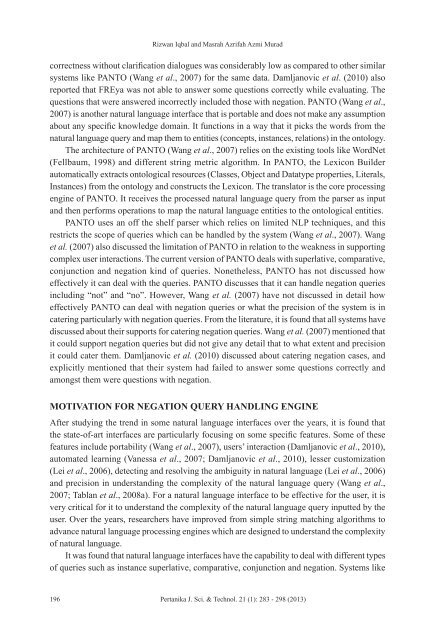JST Vol. 21 (1) Jan. 2013 - Pertanika Journal - Universiti Putra ...
JST Vol. 21 (1) Jan. 2013 - Pertanika Journal - Universiti Putra ...
JST Vol. 21 (1) Jan. 2013 - Pertanika Journal - Universiti Putra ...
You also want an ePaper? Increase the reach of your titles
YUMPU automatically turns print PDFs into web optimized ePapers that Google loves.
Rizwan Iqbal and Masrah Azrifah Azmi Murad<br />
correctness without clarification dialogues was considerably low as compared to other similar<br />
systems like PANTO (Wang et al., 2007) for the same data. Damljanovic et al. (2010) also<br />
reported that FREya was not able to answer some questions correctly while evaluating. The<br />
questions that were answered incorrectly included those with negation. PANTO (Wang et al.,<br />
2007) is another natural language interface that is portable and does not make any assumption<br />
about any specific knowledge domain. It functions in a way that it picks the words from the<br />
natural language query and map them to entities (concepts, instances, relations) in the ontology.<br />
The architecture of PANTO (Wang et al., 2007) relies on the existing tools like WordNet<br />
(Fellbaum, 1998) and different string metric algorithm. In PANTO, the Lexicon Builder<br />
automatically extracts ontological resources (Classes, Object and Datatype properties, Literals,<br />
Instances) from the ontology and constructs the Lexicon. The translator is the core processing<br />
engine of PANTO. It receives the processed natural language query from the parser as input<br />
and then performs operations to map the natural language entities to the ontological entities.<br />
PANTO uses an off the shelf parser which relies on limited NLP techniques, and this<br />
restricts the scope of queries which can be handled by the system (Wang et al., 2007). Wang<br />
et al. (2007) also discussed the limitation of PANTO in relation to the weakness in supporting<br />
complex user interactions. The current version of PANTO deals with superlative, comparative,<br />
conjunction and negation kind of queries. Nonetheless, PANTO has not discussed how<br />
effectively it can deal with the queries. PANTO discusses that it can handle negation queries<br />
including “not” and “no”. However, Wang et al. (2007) have not discussed in detail how<br />
effectively PANTO can deal with negation queries or what the precision of the system is in<br />
catering particularly with negation queries. From the literature, it is found that all systems have<br />
discussed about their supports for catering negation queries. Wang et al. (2007) mentioned that<br />
it could support negation queries but did not give any detail that to what extent and precision<br />
it could cater them. Damljanovic et al. (2010) discussed about catering negation cases, and<br />
explicitly mentioned that their system had failed to answer some questions correctly and<br />
amongst them were questions with negation.<br />
MOTIVATION FOR NEGATION QUERY HANDLING ENGINE<br />
After studying the trend in some natural language interfaces over the years, it is found that<br />
the state-of-art interfaces are particularly focusing on some specific features. Some of these<br />
features include portability (Wang et al., 2007), users’ interaction (Damljanovic et al., 2010),<br />
automated learning (Vanessa et al., 2007; Damljanovic et al., 2010), lesser customization<br />
(Lei et al., 2006), detecting and resolving the ambiguity in natural language (Lei et al., 2006)<br />
and precision in understanding the complexity of the natural language query (Wang et al.,<br />
2007; Tablan et al., 2008a). For a natural language interface to be effective for the user, it is<br />
very critical for it to understand the complexity of the natural language query inputted by the<br />
user. Over the years, researchers have improved from simple string matching algorithms to<br />
advance natural language processing engines which are designed to understand the complexity<br />
of natural language.<br />
It was found that natural language interfaces have the capability to deal with different types<br />
of queries such as instance superlative, comparative, conjunction and negation. Systems like<br />
196 <strong>Pertanika</strong> J. Sci. & Technol. <strong>21</strong> (1): 283 - 298 (<strong>2013</strong>)





